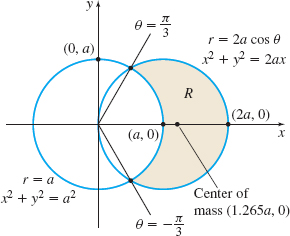EXAMPLE 2Finding the Mass and the Center of Mass of a Lamina
Find the mass M and the center of mass (ˉx,ˉy) of a lamina in the shape of a region R in the xy-plane that lies outside the circle x2+y2=a2 and inside the circle x2+y2=2ax. The mass density ρ is inversely proportional to the distance from the origin.

Solution Figure 34 illustrates the region R. Since R involves two circles, we use polar coordinates. Then the two circles are given by r=a and by r=2acosθ. The circles intersect when a=2acosθ or cosθ=12, and the points of intersection are (a,π3) and (a,−π3). The region R is given by a≤r≤2acosθ, −π3≤θ≤π3.
Since the distance of a point (x,y) from the origin is √x2+y2 , the mass density of the lamina at any point (x,y) in R is ρ(x,y)=k√x2+y2=krr2=x2+y2
where k is the constant of proportionality. Since R does not contain the origin, the mass density ρ=ρ(x,y) is continuous on R. The mass M of the lamina is M=∬
Both the mass density function and the region R are symmetric about the x-axis. So, the center of mass lies on the x-axis; that is, \bar{y}=0. To find \bar{x}, we first find M_{y}. \begin{eqnarray*} M_{y}& =&\displaystyle\iint\limits_{\kern-3ptR}x\rho (x,y)\,{\it dA}=\displaystyle\iint\limits_{\kern-3ptR}( r\cos \theta ) \left( \dfrac{k}{r}\right) r\,dr\,d\theta =k\int_{-\pi /3}^{\pi /3}\int_{a}^{2a\cos \theta }r\cos \theta \,dr\,d\theta\\[4pt] &=&\dfrac{k}{2}\int_{-\pi /3}^{\pi /3}(4a^{2}\cos ^{2}\theta -a^{2})\cos \theta \,d\theta = a^{2}\dfrac{k}{2}\int_{-\pi /3}^{\pi /3}(3-4\sin ^{2}\theta )\cos \theta \,d\theta\\[4pt] &=&\dfrac{a^{2}k}{2}\left[ 3\sin \theta -\dfrac{4\sin ^{3}\theta }{3} \right] _{-\pi /3}^{\pi /3}=ka^{2}\sqrt{3} \end{eqnarray*}
Then \bar{x}=\dfrac{M_{y}}{M}=\dfrac{ka^{2}\sqrt{3}}{\dfrac{2ka}{3}(3\sqrt{3}-\pi )} =\dfrac{3a\sqrt{3}}{2(3\sqrt{3}-\pi )}\approx 1.265a
The center of mass is approximately (1.265a,0).